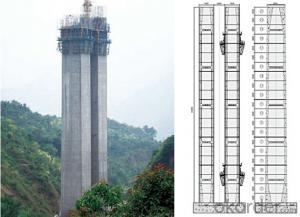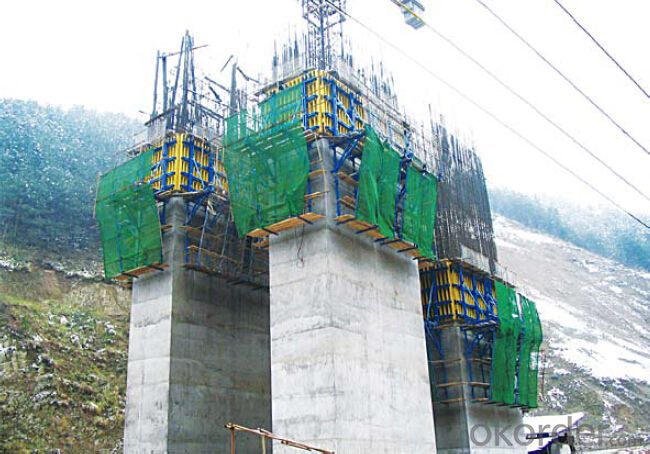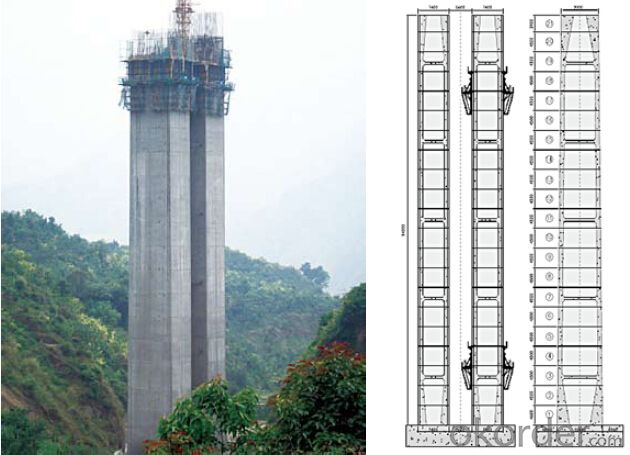Climbing Bracket CB240 for Formwork and Scaffolding Systems
- Loading Port:
- Tianjin
- Payment Terms:
- TT OR LC
- Min Order Qty:
- 50 m²
- Supply Capability:
- 1000 m²/month
OKorder Service Pledge
OKorder Financial Service
You Might Also Like
Climbing Bracket CB240 & CB210
They are framework brackets for supporting large-area wall formwork.
Typical applications for the CB240&CB210 are pier and column/shear wall/core walll/ in the
building.
CB210 has smaller size than CB240, it will be cost effective in some condition.
Characteristics:
◆ High bearing capacity
The high loading capacity of the brackets allow very large scaffold units. This saves the number
anchor points required as well as reducing climbing times.
◆ Simple moving procedure by crane
Through the strong connection of formwork together with the climbing scaffold, both can be moved
as a single climbing unit by crane. Thus valuable time-savings can be achieved.
◆ Fast striking process without a crane
With the retrusive set, large formwork elements can also be retracted quickly and a minimum of
effort.
◆ Safe with work platform
The platforms have assembled firmly with bracket and will be climbing together, without scaffolding
but can work safely in spite of your high location.
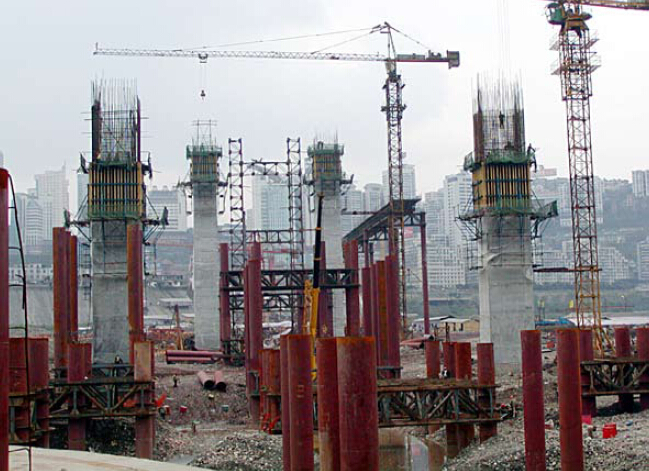
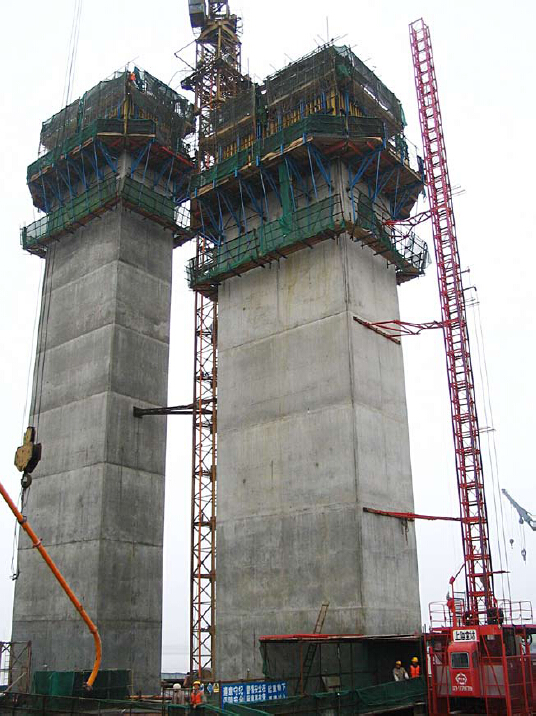
- Q: How does steel formwork contribute to the overall fire resistance of the structure?
- Steel formwork does not directly contribute to the fire resistance of a structure. However, it can indirectly enhance fire resistance by supporting the installation of fire-rated materials, such as fire-resistant coatings or insulation, which are crucial in increasing the overall fire resistance of the structure.
- Q: How is steel formwork transported to the construction site?
- Steel formwork is typically transported to the construction site by using trucks or trailers equipped with cranes or forklifts. The formwork is securely loaded onto the vehicle and then transported to the site, where it is unloaded and positioned for use in the construction process.
- Q: How does steel formwork accommodate for different concrete curing temperatures?
- Steel formwork is a versatile and reliable option for accommodating different concrete curing temperatures. The main advantage of steel formwork is its high thermal conductivity, allowing it to effectively dissipate heat from the curing concrete. This property enables the steel formwork to regulate the temperature of the concrete during the curing process. In situations where the concrete curing temperature needs to be controlled, steel formwork can be equipped with additional features to accommodate these requirements. For instance, insulation materials can be applied to the steel formwork to minimize heat loss or gain, ensuring a steady and consistent curing temperature. This is particularly useful in extreme weather conditions, where the ambient temperature can significantly impact the curing process. Moreover, steel formwork can also be used in conjunction with heating or cooling systems to further regulate the concrete curing temperature. For example, in cold weather conditions, heating elements can be integrated into the steel formwork to maintain a favorable temperature for proper curing. Similarly, in hot weather conditions, cooling systems can be employed to prevent excessive heat from affecting the curing process. Additionally, steel formwork offers excellent strength and durability, which is crucial for accommodating different concrete curing temperatures. The robust nature of steel formwork allows it to withstand the pressure and stresses exerted by the curing concrete, regardless of the temperature. This ensures that the formwork remains intact and stable throughout the curing process, preventing any deformations or failures that may compromise the quality of the concrete structure. Overall, steel formwork is an ideal choice for accommodating different concrete curing temperatures due to its high thermal conductivity, adaptability to insulation materials, and compatibility with heating or cooling systems. Its strength and durability further enhance its ability to withstand the challenges posed by varying curing temperatures, ensuring the successful and optimal curing of the concrete.
- Q: What are the different types of coatings available for steel formwork?
- There are several types of coatings available for steel formwork, including epoxy coatings, polyurethane coatings, zinc coatings, and galvanized coatings. These coatings help protect the steel from corrosion, provide better surface finish, and increase the lifespan of the formwork.
- Q: Can steel formwork be used for precast concrete arches?
- Yes, steel formwork can be used for precast concrete arches. Steel formwork provides a strong and durable structure for shaping and supporting the concrete during the casting process. It allows for the creation of precise and complex arch shapes, ensuring the desired architectural and structural requirements are met. Additionally, steel formwork can be easily customized and reused, making it a cost-effective option for precast concrete arches.
- Q: Can steel formwork be used for both residential and commercial construction projects?
- Yes, steel formwork can be used for both residential and commercial construction projects. Steel formwork is a versatile and durable option for creating concrete structures, including walls, columns, beams, and slabs. It offers several advantages such as high load-bearing capacity, dimensional accuracy, and reusability, making it suitable for various construction projects. In residential construction, steel formwork can be used for building foundations, retaining walls, and even for creating decorative elements. In commercial projects, it can be used for constructing office buildings, shopping malls, industrial facilities, and other large-scale structures. Additionally, steel formwork allows for faster construction and better quality control, resulting in time and cost savings for both residential and commercial projects.
- Q: Can steel formwork be used for tunnel linings?
- Tunnel linings can indeed utilize steel formwork, a flexible and long-lasting alternative that can be tailored to meet the precise demands of tunnel construction. This solution furnishes a robust and inflexible framework, able to withstand the immense pressures and forces exerted by the surrounding terrain and potential water infiltration. Furthermore, steel formwork boasts the added benefit of reusability, rendering it an economically viable choice for tunnel linings. Additionally, assembling and disassembling steel formwork is a simple task, facilitating the expedient and punctual construction of tunnel linings.
- Q: How does steel formwork contribute to the overall sustainability of the construction industry?
- Steel formwork contributes to the overall sustainability of the construction industry in several ways. Firstly, steel formwork is highly durable and long-lasting. It can be reused multiple times, reducing the need for new formwork materials for each construction project. This significantly reduces the amount of waste generated during the construction process and minimizes the overall environmental impact of the industry. Additionally, steel formwork is a more sustainable alternative to traditional formwork materials such as timber. Timber formwork often requires cutting down trees, which contributes to deforestation and habitat destruction. By utilizing steel formwork, we can reduce our reliance on timber and help preserve forests. Steel formwork also offers greater structural stability and strength compared to other materials. This allows for more efficient construction processes and reduces the need for additional support structures. As a result, less material is wasted, energy is saved, and the overall construction time is shortened, making the process more sustainable. Furthermore, steel formwork is highly resistant to weather conditions, corrosion, and fire. This ensures the longevity of the buildings, reducing the need for frequent repairs or replacements. By using steel formwork, we can create structures that have a longer lifespan, resulting in reduced resource consumption and waste generation over time. Lastly, steel formwork is recyclable. At the end of its life cycle, steel formwork can be easily melted down and reused for other applications. This reduces the demand for new steel production, conserving natural resources and reducing energy consumption. In conclusion, steel formwork contributes to the overall sustainability of the construction industry by being durable, reusable, resistant to weather conditions, and recyclable. Its use helps minimize waste generation, deforestation, energy consumption, and resource depletion, making it an environmentally-friendly choice for construction projects.
- Q: What are the components of a steel formwork system?
- A steel formwork system typically consists of several components that work together to create a sturdy and efficient construction formwork. These components include: 1. Steel Panels: The primary component of a steel formwork system is the steel panels. These panels are usually made of high-quality steel and come in various sizes and shapes. They are designed to withstand the pressure exerted by the concrete during the pouring process. 2. Steel Walers and Soldiers: Steel walers are horizontal members that connect the steel panels together, providing additional strength and stability to the formwork system. Soldiers, on the other hand, are vertical members that support the steel panels and prevent them from bulging or deforming under the weight of the concrete. 3. Tie Rods: Tie rods are used to hold the steel panels and walers together. They are threaded rods that pass through holes in the panels and are secured with nuts and washers. Tie rods help to maintain the structural integrity of the formwork system and resist the outward pressure exerted by the wet concrete. 4. Formwork Accessories: There are several accessories that are used in conjunction with steel formwork systems to enhance their efficiency and ease of use. These accessories include formwork clamps, formwork pins, formwork cones, and wedges. These accessories help to align and secure the formwork components, ensuring a tight fit and preventing any movement during the concrete pouring process. 5. Formwork Braces: Formwork braces are diagonal members that are used to provide additional support and stability to the formwork system. They are typically made of steel and are installed at regular intervals to prevent any sagging or buckling of the formwork. 6. Formwork Joints: Formwork joints are used to connect different sections of the steel formwork system. These joints can be either temporary or permanent, depending on the requirements of the construction project. Temporary joints are typically used for modular formwork systems, allowing for easy assembly and disassembly. Overall, a steel formwork system is a robust and durable solution for constructing concrete structures. Its components work together to create a strong and reliable formwork that can withstand the pressures exerted during the concrete pouring process.
- Q: How does steel formwork affect the overall waste management of the construction process?
- Steel formwork can have a significant impact on the overall waste management of the construction process. Unlike traditional timber formwork, steel formwork is highly durable and reusable, which helps to minimize waste generation. This is because steel formwork can be used multiple times, reducing the need for frequent replacements and thereby reducing the amount of waste generated from discarded formwork materials. Moreover, steel formwork is typically fabricated off-site and can be easily disassembled and transported to different construction sites. This not only saves time and labor but also reduces the amount of waste generated during the construction process. In addition to its reusability, steel formwork is also recyclable. At the end of its life cycle, steel formwork can be melted down and reused to produce new steel products. This allows for a closed-loop recycling system, reducing the need for raw material extraction and minimizing the environmental impact associated with steel production. Another aspect to consider is the reduced maintenance required for steel formwork compared to other types of formwork. Since steel is highly resistant to wear and tear, it requires minimal repairs or replacements. This further reduces the waste generated during the construction process. Furthermore, steel formwork offers better dimensional accuracy and stability compared to other formwork materials. This results in reduced material wastage as the formwork provides precise shape and alignment, minimizing the need for excessive concrete pouring or trimming. Overall, the use of steel formwork positively impacts waste management in the construction process by minimizing waste generation, promoting reusability, facilitating recycling, reducing maintenance needs, and enhancing construction accuracy.
Send your message to us
Climbing Bracket CB240 for Formwork and Scaffolding Systems
- Loading Port:
- Tianjin
- Payment Terms:
- TT OR LC
- Min Order Qty:
- 50 m²
- Supply Capability:
- 1000 m²/month
OKorder Service Pledge
OKorder Financial Service
Similar products
Hot products
Hot Searches

